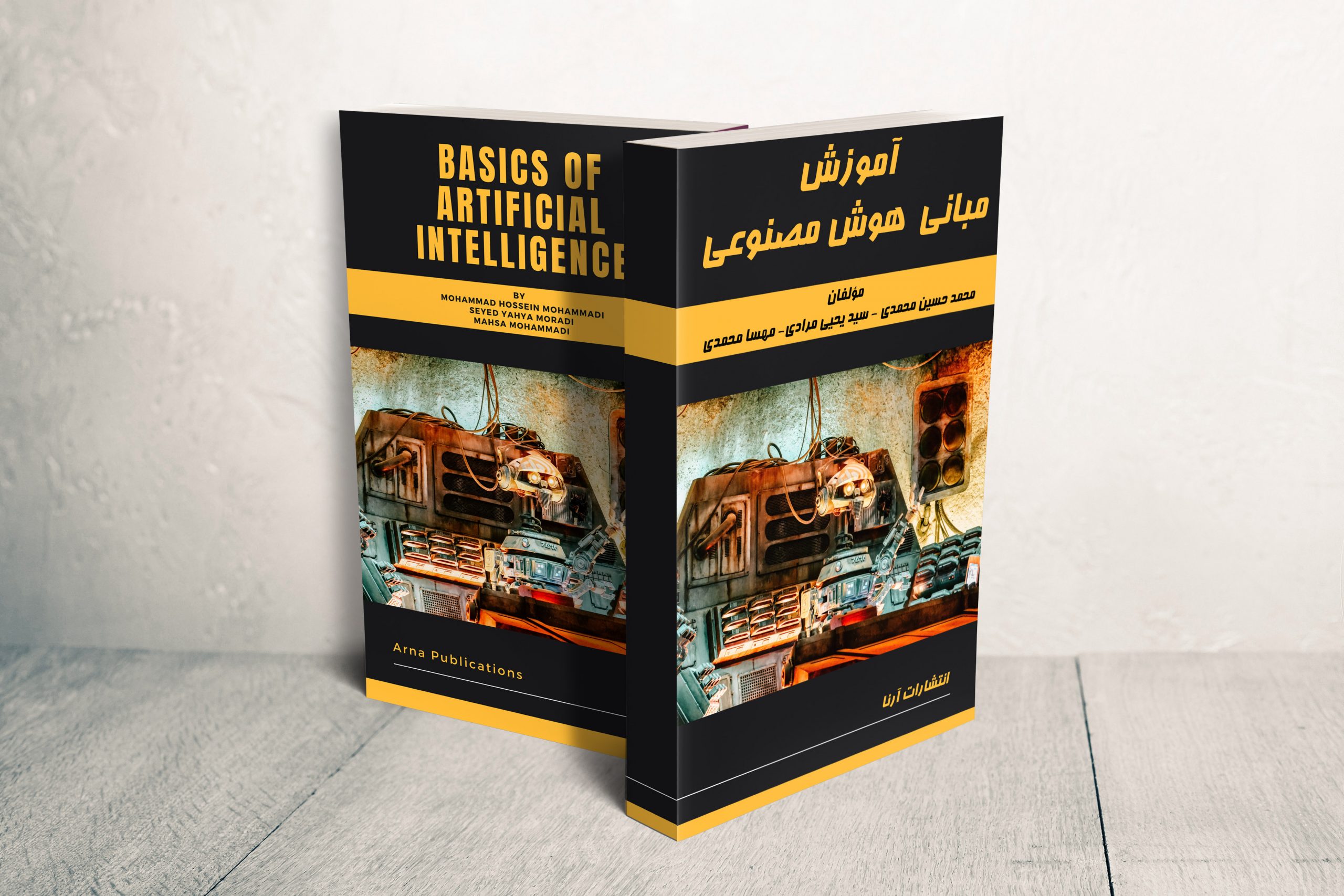Basics of Artificial Intelligence
Published in Arna, 2020

| Front Book Cover | Back Book Cover |
|---|---|
| Book Name | ArtificialIntelligence |
| Authors | M.H.Mohammadi, S.Y.Moradi, M.Mohammadi |
| language | Persian |
| Printed in the | IRAN |
| Publisher | Arna |
| First Printing Edition | Jun 2021 |
| Print Length | 243 |
| ISBN | 978-622-291-049-5 |
〽️Introduction:
Artificial intelligence (AI) is intelligence demonstrated by machines, unlike the natural intelligence displayed by humans and animals, which involves consciousness and emotionality. The distinction between the former and the latter categories is often revealed by the acronym chosen. ‘Strong’ AI is usually labelled as AGI (Artificial General Intelligence) while attempts to emulate ‘natural’ intelligence have been called ABI (Artificial Biological Intelligence). Leading AI textbooks define the field as the study of “intelligent agents”: any device that perceives its environment and takes actions that maximize its chance of successfully achieving its goals. Colloquially, the term “artificial intelligence” is often used to describe machines (or computers) that mimic “cognitive” functions that humans associate with the human mind, such as “learning” and “problem solving”.
As machines become increasingly capable, tasks considered to require “intelligence” are often removed from the definition of AI, a phenomenon known as the AI effect. A quip in Tesler’s Theorem says “AI is whatever hasn’t been done yet.” For instance, optical character recognition is frequently excluded from things considered to be AI, having become a routine technology. Modern machine capabilities generally classified as AI include successfully understanding human speech, competing at the highest level in strategic game systems (such as chess and Go), and also imperfect-information games like poker, self-driving cars, intelligent routing in content delivery networks, and military simulations.
Artificial intelligence was founded as an academic discipline in 1955, and in the years since has experienced several waves of optimism, followed by disappointment and the loss of funding (known as an “AI winter”), followed by new approaches, success and renewed funding. After AlphaGo successfully defeated a professional Go player in 2015, artificial intelligence once again attracted widespread global attention. For most of its history, AI research has been divided into sub-fields that often fail to communicate with each other. These sub-fields are based on technical considerations, such as particular goals (e.g. “robotics” or “machine learning”), the use of particular tools (“logic” or artificial neural networks), or deep philosophical differences. Sub-fields have also been based on social factors (particular institutions or the work of particular researchers).
The traditional problems (or goals) of AI research include reasoning, knowledge representation, planning, learning, natural language processing, perception and the ability to move and manipulate objects. General intelligence is among the field’s long-term goals. Approaches include statistical methods, computational intelligence, and traditional symbolic AI. Many tools are used in AI, including versions of search and mathematical optimization, artificial neural networks, and methods based on statistics, probability and economics. The AI field draws upon computer science, information engineering, mathematics, psychology, linguistics, philosophy, and many other fields.
The field was founded on the assumption that human intelligence “can be so precisely described that a machine can be made to simulate it”. This raises philosophical arguments about the mind and the ethics of creating artificial beings endowed with human-like intelligence. These issues have been explored by myth, fiction and philosophy since antiquity. Some people also consider AI to be a danger to humanity if it progresses unabated. Others believe that AI, unlike previous technological revolutions, will create a risk of mass unemployment.
In the twenty-first century, AI techniques have experienced a resurgence following concurrent advances in computer power, large amounts of data, and theoretical understanding; and AI techniques have become an essential part of the technology industry, helping to solve many challenging problems in computer science, software engineering and operations research.
Contents
- Chapter 1: Artificial Intelligence
- Chapter 2: Intelligent Agent
- Chapter 3: Problem-solving
- Chapter 4: Adversarial Search
- Chapter 5: Knowledge Represent
- Chapter 6: Uncertain Knowledge R.
- Chapter 7: Subsets of AI
- Chapter 8: Artificial Intelligence MCQ
Chapter 1
Artificial Intelligence
The Artificial Intelligence tutorial provides an introduction to AI which will help you to understand the concepts behind Artificial Intelligence. In this tutorial, we have also discussed various popular topics such as History of AI, applications of AI, deep learning, machine learning, natural language processing, Reinforcement learning, Q-learning, Intelligent agents, Various search algorithms, etc.
🔹 Topics in this chapter include
| Chapter 1 | ||
|---|---|---|
| 1-1 AI Tutorial | 1-3 Application of AI | 1-5 Types of AI |
| 1-2 AI Introduction | 1-4 History of AI |
Chapter 2
Intelligent Agent
An AI system can be defined as the study of the rational agent and its environment. The agents sense the environment through sensors and act on their environment through actuators. An AI agent can have mental properties such as knowledge, belief, intention, etc.
🔹 Topics in this chapter include
| Chapter 2 | |
|---|---|
| 2-1 Types of Agents | 2-3 Agent Environment |
| 2-2 Intelligent Agent | 2-4 Turing Test in AI |
Chapter 3
Problem-solving
In Artificial Intelligence, Search techniques are universal problem-solving methods. Rational agents or Problem-solving agents in AI mostly used these search strategies or algorithms to solve a specific problem and provide the best result. Problem-solving agents are goal-based agents and use atomic representation. In this topic, we will learn various problem-solving search algorithms.
🔹 Topics in this chapter include
| Chapter 3 | ||
|---|---|---|
| 3-1 Search Algorithms | 3-3 Informed Search Algorithms | 3-5 Means-Ends Analysis |
| 3-2 Uninformed Search Algorithm | 3-4 Hill Climbing Algorithm |
Chapter 4
Adversarial Search
Adversarial search is a search, where we examine the problem which arises when we try to plan ahead of the world and other agents are planning against us.
- In previous topics, we have studied the search strategies which are only associated with a single agent that aims to find the solution which often expressed in the form of a sequence of actions.
- But, there might be some situations where more than one agent is searching for the solution in the same search space, and this situation usually occurs in game playing.
- The environment with more than one agent is termed a multi-agent environment, in which each agent is an opponent of another agent and playing against each other. Each agent needs to consider the action of another agent and the effect of that action on their performance.
- So, Searches in which two or more players with conflicting goals are trying to explore the same search space for the solution, are called adversarial searches, often known as Games.
- Games are modeled as a Search problem and heuristic evaluation function, and these are the two main factors that help to model and solve games in AI.
🔹 Topics in this chapter include
| Chapter 4 | ||
|---|---|---|
| 4-1 Adversarial search | 4-2 Minimax Algorithm | 4-3 Alpha-Beta Pruning |
Chapter 5
Knowledge Represent
An intelligent agent needs knowledge about the real world for taking decisions and reasoning to act efficiently.
Knowledge-based agents are those agents who have the capability of maintaining an internal state of knowledge, reason over that knowledge, update their knowledge after observations and take actions. These agents can represent the world with some formal representation and act intelligently.
Knowledge-based agents are composed of two main parts:- Knowledge-base and
- Inference system.
A knowledge-based agent must able to do the following:
- An agent should be able to represent states, actions, etc.
- An agent Should be able to incorporate new percepts
- An agent can update the internal representation of the world
- An agent can deduce the internal representation of the world
- An agent can deduce appropriate actions.
🔹 Topics in this chapter include
| Chapter 5 | |||
|---|---|---|---|
| 5-1 Knowledge Based Agent | 5-5 Rules of Inference | 5-9 Knowledge Engineering in FOL | 5-13 Forward Chaining and backward chaining |
| 5-2 Knowledge Representation | 5-6 The Wumpus world | 5-10 Inference in First-Order Logic | 5-14 Backward Chaining vs Forward Chaining |
| 5-3 Knowledge Representation Techniques | 5-7 Knowledge-base for Wumpus World | 5-11 Unification in FOL | 5-15 Reasoning in AI |
| 5-4 Propositional Logic | 5-8 First-order logic | 5-12 Resolution in FOL | 5-16 Inductive vs. Deductive reasoning |
Chapter 6
Uncertain Knowledge R.
Till now, we have learned knowledge representation using first-order logic and propositional logic with certainty, which means we were sure about the predicates. With this knowledge representation, we might write A→B, which means if A is true then B is true, but consider a situation where we are not sure about whether A is true or not then we cannot express this statement, this situation is called uncertainty.
So to represent uncertain knowledge, where we are not sure about the predicates, we need uncertain reasoning or probabilistic reasoning.
🔹 Topics in this chapter include
| Chapter 6 | ||
|---|---|---|
| 6-1 Probabilistic Reasoning in AI | 6-2 Bayes theorem in AI | 6-3 Bayesian Belief Network |
Chapter 7
Subsets of AI
Till now, we have learned about what is AI, and now we will learn this topic about various subsets of AI. Following are the most common subsets of AI:
- Machine Learning
- Deep Learning
- Natural Language processing
- Expert System
- Robotics
- Machine Vision
- Speech Recognition
🔹 Topics in this chapter include
| Chapter 7 | |
|---|---|
| 7-1 Subsets of AI | 7-3 Machine Learning Tutorial |
| 7-2 Expert Systems | 7-4 NLP Tutorial |
Chapter 8
Artificial Intelligence MCQ
🔹 Topics in this chapter include
| Chapter 8 |
|---|
| 8-1 Artificial Intelligence MCQ |
Authors
| Order | Pic | Name | Information |
|---|---|---|---|
| The First |  | Mohammad Hossein Mohammadi | 1. Personal Website 2. LinkedIn 3. M.H.Mohammadimir2017@gmail.com |
| The Second |  | Seyed Yahya Moradi | 1. Personal Website 2. LinkedIn 3. S.YahyaMoradi@yahoo.com |
| Third |  | Mahsa Mohammadi | 1. Personal Website 2. LinkedIn 3. MmMohammadi4820@gmail.com |
